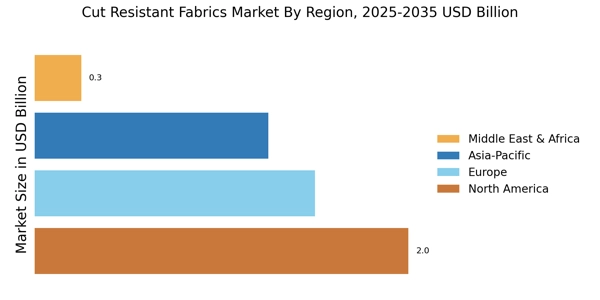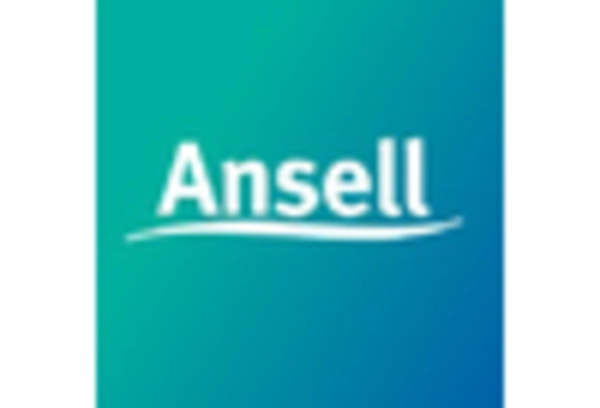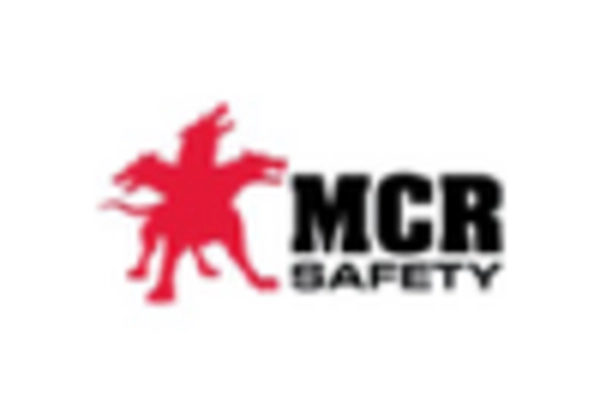Expansion of End-Use Industries
The Cut Resistant Fabrics Market is poised for growth due to the expansion of end-use industries such as automotive, aerospace, and food processing. These sectors are increasingly adopting cut-resistant materials to enhance safety and efficiency in their operations. For instance, the automotive industry utilizes cut-resistant fabrics in manufacturing processes to protect workers from sharp tools and components. Similarly, the food processing industry employs these fabrics to ensure safety during food handling and preparation. As these industries continue to expand, the demand for cut-resistant fabrics is expected to rise, potentially leading to a market valuation of USD 1.5 billion by 2028. This trend indicates a robust opportunity for manufacturers within the Cut Resistant Fabrics Market to cater to diverse applications.
Increased Awareness of Workplace Safety
The Cut Resistant Fabrics Market is benefiting from a heightened awareness of workplace safety among employers and employees alike. As industries recognize the financial and human costs associated with workplace injuries, there is a concerted effort to implement protective measures. This awareness is driving the demand for cut-resistant fabrics, particularly in sectors where the risk of cuts and lacerations is prevalent. The market is likely to see a significant uptick in demand as companies prioritize employee safety and invest in protective gear made from cut-resistant materials. Furthermore, educational campaigns and training programs are being developed to inform workers about the importance of using appropriate protective clothing, thereby fostering a culture of safety that could further propel the growth of the Cut Resistant Fabrics Market.
Rising Safety Regulations and Standards
The Cut Resistant Fabrics Market is significantly influenced by the increasing implementation of safety regulations and standards across various sectors. Governments and regulatory bodies are mandating higher safety standards for protective clothing, particularly in industries such as construction, manufacturing, and healthcare. This regulatory push is compelling companies to adopt cut-resistant materials to ensure compliance and protect their workforce. For instance, the introduction of standards such as EN 388 in Europe and ANSI/ISEA 105 in the United States has heightened awareness regarding the importance of cut protection. As a result, the demand for cut-resistant fabrics is expected to rise, with the market projected to reach a valuation of USD 1.2 billion by 2027, reflecting the growing emphasis on workplace safety.
Sustainability Trends in Fabric Production
The Cut Resistant Fabrics Market is increasingly influenced by sustainability trends that prioritize eco-friendly practices in fabric production. Manufacturers are exploring the use of recycled materials and sustainable production methods to meet consumer demand for environmentally responsible products. This shift not only addresses environmental concerns but also appeals to a growing segment of consumers who prioritize sustainability in their purchasing decisions. The market is likely to see a rise in the availability of cut-resistant fabrics made from organic or recycled fibers, which could enhance brand loyalty and market share for companies that adopt these practices. As sustainability becomes a key driver in the textile industry, the Cut Resistant Fabrics Market may witness a transformation that aligns with broader environmental goals.
Technological Innovations in Cut Resistant Fabrics
The Cut Resistant Fabrics Market is experiencing a surge in technological innovations that enhance the performance and durability of fabrics. Advanced weaving techniques and the incorporation of high-performance fibers, such as aramid and UHMWPE, are becoming increasingly prevalent. These innovations not only improve cut resistance but also enhance comfort and flexibility, making them suitable for various applications, including industrial safety and personal protective equipment. The market is projected to grow at a compound annual growth rate (CAGR) of approximately 5.5% over the next few years, driven by these advancements. As manufacturers invest in research and development, the introduction of smart textiles that can monitor wear and tear is also on the horizon, potentially revolutionizing the Cut Resistant Fabrics Market.


















Leave a Comment